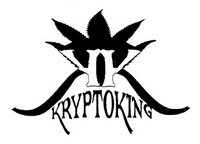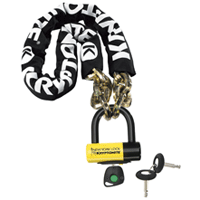"KRYPTONITE" Opposition to "KRYPTOKING" Goes up in Smoke at the TTAB
The Board slammed the door on Schlage Lock Company in the latter's opposition to registration of the mark KRYPTOKING & design (shown immediately below) for sunglasses, tote bags, wallets, various clothing items, cigars, cigarettes, tobacco, and rolling papers. Schlage claimed that the applied-for mark would cause confusion with and dilute its KRYPTONITE and KRYPTO-formative marks for a wide variety of goods, and that Applicant's mark is immoral and scandalous under Section 2(a). Schlage Lock Co. v. Staiano, Opposition No. 91152703 (December 12, 2005) [not citable].
 Before reaching the substantive issues, the Board decided several procedural and evidentiary matters. For example, it rejected Schlage's contention that Applicant Staiano had admitted (by not denying) the Section 2(a) allegations, concluding that the issue had been tried by the parties; it therefore considered Applicant's Answer to be amended to conform to the evidence. And the Board sustained Applicant's objection to several website excerpts submitted under a Notice of Reliance, noting that webpage printouts are not self-authenticating but must be submitted with testimony. See Raccioppi v. Apogee Inc., 47 USPQ2d 1368 (TTAB 1998).
Before reaching the substantive issues, the Board decided several procedural and evidentiary matters. For example, it rejected Schlage's contention that Applicant Staiano had admitted (by not denying) the Section 2(a) allegations, concluding that the issue had been tried by the parties; it therefore considered Applicant's Answer to be amended to conform to the evidence. And the Board sustained Applicant's objection to several website excerpts submitted under a Notice of Reliance, noting that webpage printouts are not self-authenticating but must be submitted with testimony. See Raccioppi v. Apogee Inc., 47 USPQ2d 1368 (TTAB 1998).The Board promptly rejected Schlage's KRYPTO family-of-marks argument, noting the lack of any evidence regarding how the marks are promoted and perceived by consumers. It likewise rejected Schlage's assertion of "fame" (and its dilution claim), pointing out that the mere ownership of incontestable registrations is not sufficient to establish a mark's fame.
With regard to 12 of the 13 registrations pleaded by Opposer, the various metal locks, cables, and carrying brackets covered by those registrations were not sufficiently similar or related to Applicant's goods. Schlage asserted that its goods would be sold in the same large discount retail stores as Applicant's sunglasses and clothing, but the Board rejected that logic:
"The mere fact that a consumer can purchase a gallon of milk and a car battery at these establishments does not lead to the conclusion that car batteries and milk are related under relevant trademark law."
As to the single remaining registration (for the mark KRYPTONITE), its tote bags for bicyclists overlapped with Applicant's "tote bags." Consequently, the Board proceeded with its du Pont analysis regarding this registration.
Comparing Applicant's mark with the mark KRYPTONITE, the Board found them "substantially different" in appearance, similar in sound only as to the beginning "KRYPTO" portion, different in connotation ("in view of the second portion of applicant's mark, KING"), and, finally, dissimilar as to overall commercial impression. The Board concluded that the marks "are not similar" and that this dissimilarity "simply outweighs the other relevant du Pont factors." It therefore ruled that confusion is not likely regarding these marks.

Turning to the Section 2(a) claim, the Board noted that the determination of whether a mark comprises immoral or scandalous matter "is to be ascertained in the context of contemporary attitudes, and the relevant viewpoint is not necessarily that of a majority of the general public, but of a 'substantial composite.'" Schlage failed to submit any evidence addressing that viewpoint, but instead offered mere "speculation and dissection of the mark." Schlage claimed that Applicant's mark contains the design of a marijuana leaf and the word "toking," and that the goods "are designed for marijuana smoking."
The Board, however, noted that "the goods for which applicant seeks registration are legal and may be used in connection with legal goods." Moreover, the record was devoid of evidence that a substantial composite of the general public would (1) perceive the leaf design as a marijuana leaf (Applicant described the design element of its mark as "the design of an aloe plant"), (2) "parse out" the word KRYPTOKING to find the word "toking" and know its meaning; or (3) find use of the mark immoral or scandalous for the identified goods.
Thus Shlage's Section 2(a) claim, too, went up in smoke.
Text Copyright John L. Welch 2005.




0 Comments:
Post a Comment
<< Home